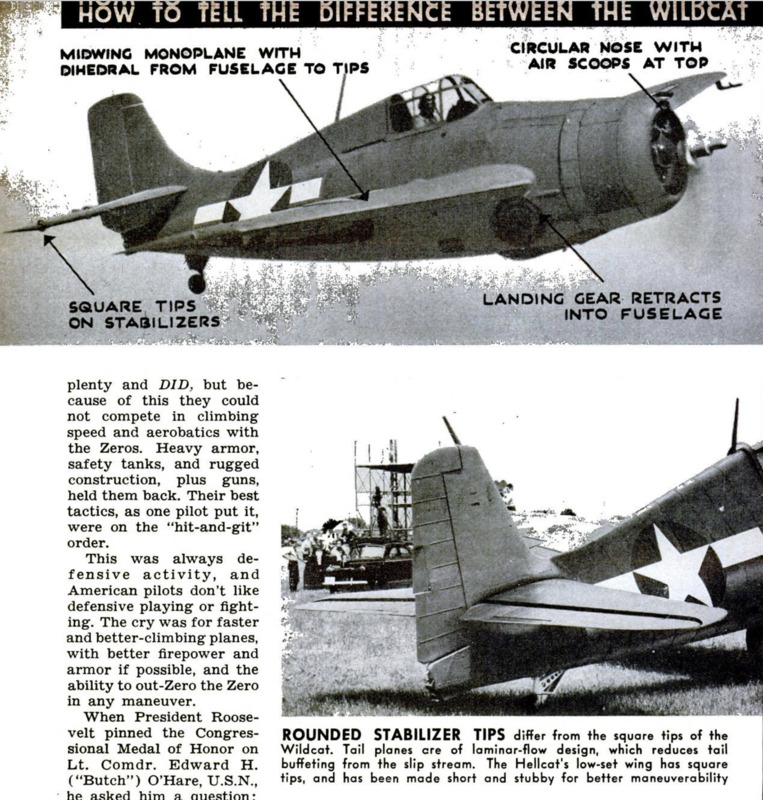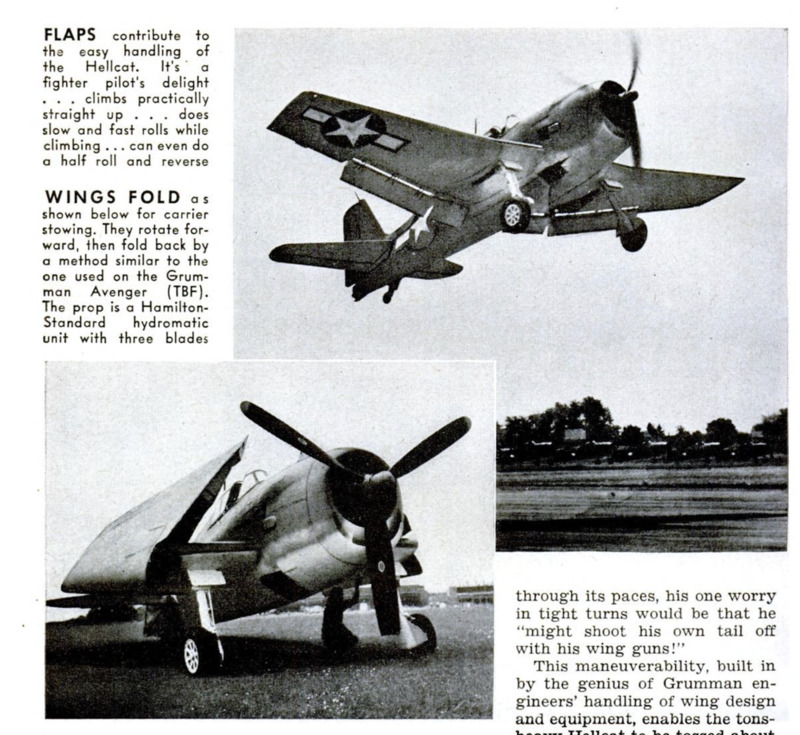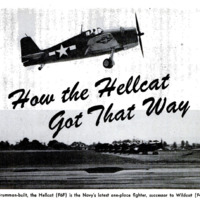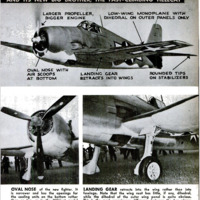-
Title (Dublin Core)
-
The Hellcat
-
Article Title and/or Image Caption (Dublin Core)
-
How the Hellcat Got That Way
-
extracted text (Extract Text)
-
The lanky fighter pilot pulled the jack |
on his throat microphone and disgustedly |
slammed back the hatch of his Grumman |
F4F Wildcat. As he hoisted his frame over
the side and dropped to the wing, he mut-
tered, “Damn it, it's like swatting mos-
quitoes with a club. If you hit him it's a
mess, but the trick is to hit the blank-
blank thing!”
That, in the words of a fighter pilot, just
about summed up the heartbreaking situa-
tion after the Japs introduced their famous
Zero fighter. These faster and more acro-
batic, although fragile, fighters stunned the
American pilots with their flashing hit-and-
run tactics and dazzling maneuverability.
Although bewildered, the stubborn Navy
flyers went into a huddle to devise ways
and means of overcoming this challenge
with what fighter equipment they had at
hand, mainly the Wildcat.
The success of these huddles and the
tactics developed through them is evidenced
by the amazing box scores hung up by our
pilots in the southwest theater of operations.
To quote a Navy-approved Grumman re-
lease: “In the Pacific the Wildcat achieved
a combat record of better than ten to one
against the Zeros and Jap bombers,” and
one fighter squadron, Navy Fighter Squad-
ron Five, (“Tojo Meets a Wildcat,” P.S.M.,
Aug. '43, p. 96) bagged 93 Japs in nine
weeks. But this was still defensive football
as far as the pilots were concerned.
The F4F's had guns, armor, and leak-
proof tanks and would hold together when
hit, but our pilots cried for steeds worthy
of their ambitions. The F4F's could take
plenty and DID, but be-
cause of this they could
not compete in climbing
speed and aerobatics with
the Zeros. Heavy armor,
safety tanks, and rugged
construction, plus guns,
held them back. Their best
tactics, as one pilot put it,
were on the “hit-and-git”
order.
This was always de-
fensive activity, and
American pilots don't like
defensive playing or fight-
ing. The cry was for faster
and better-climbing planes,
with better firepower and
armor if possible, and the
ability to out-Zero the Zero
in any maneuver.
‘When President Roose-
velt pinned the Congres-
sional Medal of Honor on
Lt. Comdr. Edward H.
(“Butch”) O'Hare, U.S.N.,
he asked him a question:
“Butch, what kind of fighter plane do you
need to beat the Japs?”
“Something that will go upstairs faster,”
was O'Hare's reply.
Things have to happen fast in wartime,
and they did. Leon A. (“Jake”) Swirbul,
Grumman's dynamic vice-president and
general manager, stuffed a notebook and
a spare shirt into a musette bag and hustled
out to Pearl Harbor almost before the smoke
of the battle of Midway had ceased to eddy,
and went into a huddle with the pilots. He
wanted to find out what they wanted in a
plane, not what Congress or some theorist
thought they wanted. One pilot in par-
ticular was questioned--Lt. Comdr. John
Smith (“Jimmy”) Thach, U.S.N., one of the
Navy's best authorities on fighter tactics
and ‘a squadron leader of long experience
against the Japs.
Jimmy in four words gave Jake the for-
mula for the plane they wanted: “More
climb and speed.”
Jake snapped his notebook shut, repacked
his shirt and hustled right back to Long
Island, N. Y. where he and William T.
(“Bill”) Schwendler, co-designer with Leroy
R. Grumman of the Wildcat, got their
heads together.
These two condensed the four-word formu-
la of “more climb and speed” into a one-
word aircraft—Hellcat! (See P.S.M.,, Nov.
'43, p. 72.) This ship, designed by and for
pilots in action, is a worthy successor to the
famous Wildcat, which held the fort during
the incubation of its younger but tougher
brother.
To get the required attributes into such
a ship as the F6F Hellcat, Jake, Bill, and
Roy needed more power. Not merely
more power for speed and climb, but power
to give, along with these demanded qualities,
what our country believes our fighters de-
serve—armor, leakproof®tanks, all the guns
needed, and every safety device that can be
packed into the compact aerial gun plat-
form we call a fighter plane.
This “more power” meant to the Grum-
man Company a new high-altitude Pratt &
‘Whitney engine already in production—the
most powerful thing Navy combat flying
had known in the shape of a power plant.
Speed was the spur, and already the plans
for the Hellcat were in tentative form, for
the Grumman Company, having learned of
the coming of this engine, had laid plans
for a ship to carry it. These plans were now
modified to follow the suggestions and de-
mands of the O'Hares and Thaches. A new
factory was rushed to completion, even as
the first experimental plane was undergoing
tests.
This first plane flew in August, 1942, and
at that time ground was broken for the
factory to produce the new fighters in
quantity. In September the first handmade
model was delivered. In October the first
jigs were installed and production parts
began to pile up. In November the first
production plane rolled out of the doors,
even though the plant was but three-quar-
ters finished and the workers were working
without heat.
It is a tribute to Grumman production
and design that, according to an official of
the Bureau of Aeronautics, there has never
been a plane in the history of the bureau
with fewer “bugs,” or defects that have to
be remedied before the plane can be put into
all-out production.
The Hellcat inherited all the good qualities
of the Wildcat, plus plenty more. Weighing
thousands of pounds more than the F4F,
itself no pygmy, the Hellcat has, neverthe-
less, greatly increased range, speed, climb,
and ceiling, plus that most important of
qualities, lightning maneuverability. Like
many other U.S. fighter planes, it can also
carry bombs, a full-size torpedo, or an
auxiliary belly tank.
As one fighter pilot said after putting it
through its paces, his one worry
in tight turns would be that he
“might shoot his own tail off
with his wing guns!”
This maneuverability, built in
by the genius of Grumman en-
gineers’ handling of wing design
and equipment, enables the tons-
heavy Hellcat to be tossed about
with the abandon of a trainer. This, com-
bined with its improved armor, its batteries
of .50 caliber guns fed by extra large ammo;
boxes, gives it a very long combat life.
A unique placing of the engine gives
added visibility, one of the “musts” de-
manded by the pilots, plus added ease in|
handling on take-off and in turns. The engine
mount, instead of being at the conventional
right angles to the longitudinal axis, is
canted to one side. This gives a narrower
front, aiding visibility forward and down,
plus a decrease in propeller torque, which
has a tendency to swerve the plane in take
offs and maneuvers. |
These added gmalities were attained
through the clever translation of design.
demands into proved engineering procedures.
All in all, the Hellcat had to be, for it
was sorely needed; it had to be because
Grumman’ engineers could produce it, and
because our O'Hares and Thaches and Jones
and Polonskvs asked for it!
-
Contributor (Dublin Core)
-
C. B. Colby (writer)
-
Robert F. Smith (photographer)
-
Language (Dublin Core)
-
eng
-
Date Issued (Dublin Core)
-
1943-12
-
pages (Bibliographic Ontology)
-
71-74
-
Rights (Dublin Core)
-
Public Domain (Google digitized)
-
Archived by (Dublin Core)
-
Matteo Ridolfi
-
Alberto Bordignon (Supervisor)
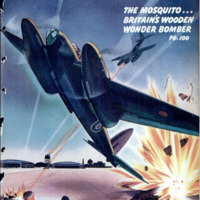 Popular Science Monthly, vol. 143, n. 6, 1943
Popular Science Monthly, vol. 143, n. 6, 1943


